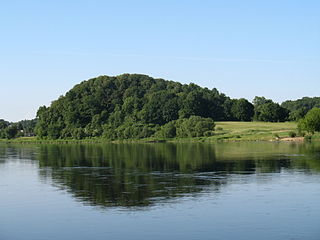
Kaunas is the second-largest city in Lithuania after Vilnius and an important centre of Lithuanian economic, academic, and cultural life. Kaunas was the largest city and the centre of a county in the Duchy of Trakai of the Grand Duchy of Lithuania and Trakai Palatinate since 1413. In the Russian Empire, it was the capital of the Kaunas Governorate from 1843 to 1915.

Vytautas Magnus University (VMU) is a public university in Kaunas, Lithuania. The university was founded in 1922 during the interwar period as an alternate national university.

Kaunas University of Technology is a public research university located in Kaunas, Lithuania. Established in 1922, KTU has been one of Lithuania's top science education centers. According to rankings conducted in 2021, KTU was the second-best university in Lithuania. The primary language spoken in courses is Lithuanian, although there are courses that are taught jointly in Lithuanian and English or solely in English.

The Aleksotas elderate is an elderate in the southern section of the city of Kaunas, Lithuania, bordering the left bank of the Nemunas River. Its population in 2006 was 21,694. The elderate borders Vilijampolė and Centras in the north, Šančiai and Panemunė in the east, Garliava in the south as well as Akademija in the west.

The Centras Eldership is an Eldership in the city of Kaunas, Lithuania, based on two neighbourhoods of Kaunas - the Old City and the New City. It lies at the confluence of two major Lithuanian rivers, the Nemunas and the Neris. The borough borders Žaliakalnis in the north, Šančiai in the east, Aleksotas in the south and Vilijampolė in the west.

Kaunas Priest Seminary is the largest seminary in Lithuania serving the Roman Catholic Archdiocese of Kaunas. It is part of the Faculty of Theology of Vytautas Magnus University. Its current rector is Aurelijus Žukauskas. As of 2007, the seminary had 35 students. It traces its history to 1622.

Church of Vytautas the Great or the Church of the Assumption of the Blessed Virgin Mary is a Roman Catholic church in the Old Town of Kaunas, Lithuania, and is the oldest church in the city and an important example of Gothic architecture in Lithuania, having the only Gothic cross-shaped plan in Lithuania.

The Vytautas the Great War Museum is a museum in Kaunas, Lithuania. It was built in Art Deco and early functionalism style.

Žaliakalnis Funicular is a funicular railway in Kaunas, Lithuania. Built in 1931, it is the oldest funicular in Lithuania and is among the oldest vehicles of such type in the world still operational. The funicular is made of a wood-paneled coachwork and climbs 142 metres (466 ft) up from behind the Vytautas the Great War Museum to the Basilica of the Resurrection.

Ąžuolynas is a public park in Lithuania's second largest city, Kaunas, in the Žaliakalnis elderate. The park covers about 84 hectares and is the largest urban stand of mature oaks in Europe. Vydūnas Alley serves as the park's northern border. It is a popular recreational destination for the inhabitants of Kaunas. Most of its trees are oaks ranging in age from 100 to 320 years old, but it also holds linden, birch, and maple trees.
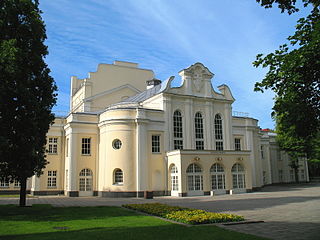
The Kaunas State Musical Theatre is a musical theatre in Kaunas, Lithuania. It was established on November 27, 1940, in the former State Theatre hall adjoining the Laisvės Alėja. For some time, it mostly presented operettas.
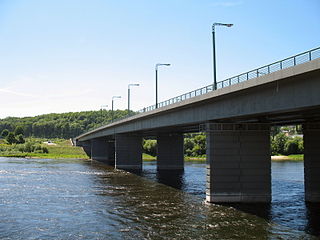
M. K. Čiurlionis Bridge is a bridge in Kaunas, Lithuania. It crosses the Nemunas River to connect Freda and Kaunas City center. The bridge is 475 meters in length and 29.4 meters in width. It carries six lanes of automobile traffic, with three lanes in each direction. The bridge, completed in 2002, is named after a prominent Lithuanian painter Mikalojus Konstantinas Čiurlionis.

Railway Bridge in Kaunas crosses Nemunas river to connect Central Kaunas and lower Freda of Aleksotas district. Because of its green paint, it is often called Green. Construction of the bridge started in 1859 and ended in 1862. The usage of the bridge started on the 4 February 1862. Together with central Kaunas Railway Station and Kaunas Railway Tunnel, it forms an important Kaunas railway hub in Lithuania. However, during World War I parts of the bridge were destroyed, but soon afterwards were rebuilt as well as the standard gauge was laid by Germans during World War I. Paul von Hindenburg was among the guests who participated in the opening ceremony of the reconstructed bridge. During World War II, the bridge was blown up several times, but was rebuilt later. Kaunas Railway Bridge was included into the Registry of Immovable Cultural Heritage Sites of the Republic of Lithuania in 1996.

Kaunas Fortress is the remains of a fortress complex in Kaunas, Lithuania. It was constructed and renovated between 1882 and 1915 to protect the Russian Empire's western borders, and was designated a "first-class" fortress in 1887. During World War I, the complex was the largest defensive structure in the entire state, occupying 65 km2 (25 sq mi).
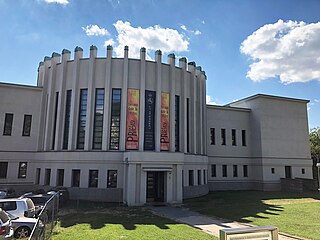
The M. K. Čiurlionis National Art Museum is a group of museums based in Kaunas, Lithuania. It is primarily dedicated to exhibiting and publicizing the works of the painter and musician M.K. Čiurlionis (1875–1911).
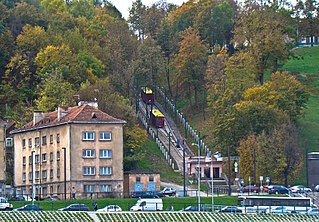
Aleksotas Funicular is a funicular railway located in Aleksotas elderate of Kaunas, Lithuania. The funicular constructed on the right bank of the Nemunas River was officially opened on 6 December 1935. The track of the Aleksotas funicular remained unchanged. The track has a separation in the centre of the track for carriages to pass. Special automatic brakes were installed in carriages not to let them run down in case of cable damage. The length of funicular is 132.9 metres (436 ft), gradient - 18 degrees. Authentic traction equipment, including the genuine pre-war wagons, wooden seats, and stop platforms of the funicular are still used.

Church of Saint Nicholas (of Benedictine Sisters) (Lithuanian: Kauno Šv. Mikalojaus (Benediktinių) bažnyčia) is a Roman Catholic church in the Old Town of Kaunas, Lithuania.
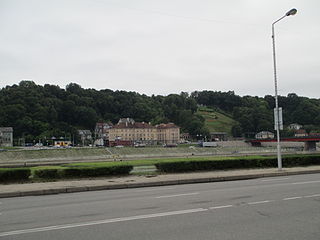
Aleksotas Hill is a hill in Kaunas near Nemunas River. There is an observation deck to the Kaunas Old Town which was renovated in 2020 and Aleksotas Funicular.
Lithuanian Air Lines was a national state-owned airline of Lithuania, operating in 1938–1940. Its hub was in Kaunas Aleksotas airport.











